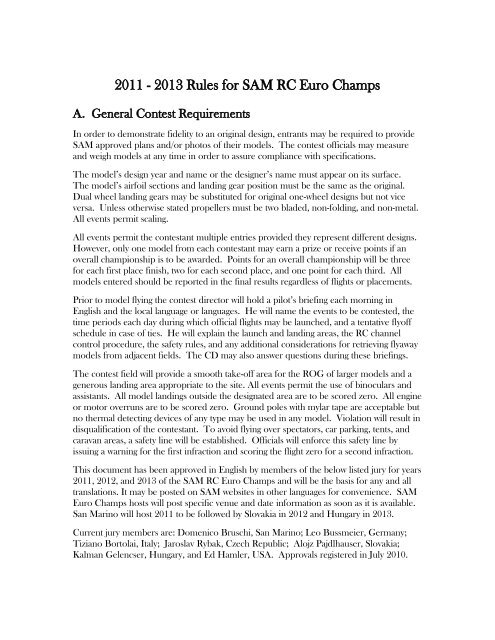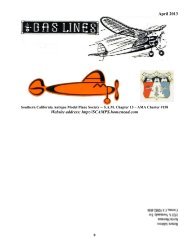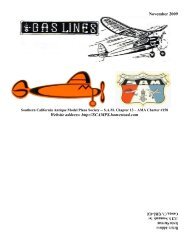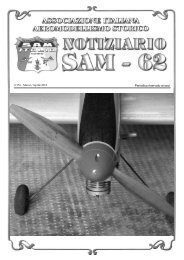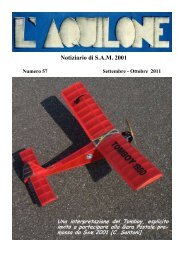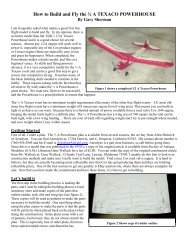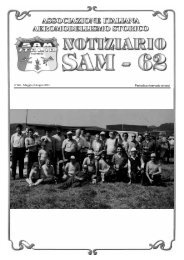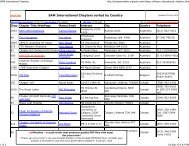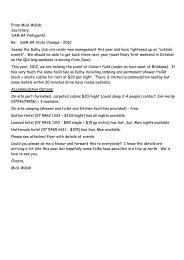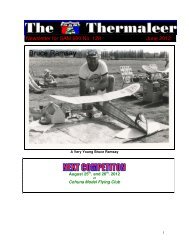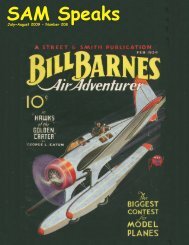Rules for SAM RC Euro. Champs - Society of Antique Modelers
Rules for SAM RC Euro. Champs - Society of Antique Modelers
Rules for SAM RC Euro. Champs - Society of Antique Modelers
You also want an ePaper? Increase the reach of your titles
YUMPU automatically turns print PDFs into web optimized ePapers that Google loves.
2011 - 2013 <strong>Rules</strong> <strong>for</strong> <strong>SAM</strong> <strong>RC</strong> <strong>Euro</strong> <strong>Champs</strong><br />
A. General Contest Requirements<br />
In order to demonstrate fidelity to an original design, entrants may be required to provide<br />
<strong>SAM</strong> approved plans and/or photos <strong>of</strong> their models. The contest <strong>of</strong>ficials may measure<br />
and weigh models at any time in order to assure compliance with specifications.<br />
The model’s design year and name or the designer’s name must appear on its surface.<br />
The model’s airfoil sections and landing gear position must be the same as the original.<br />
Dual wheel landing gears may be substituted <strong>for</strong> original one-wheel designs but not vice<br />
versa. Unless otherwise stated propellers must be two bladed, non-folding, and non-metal.<br />
All events permit scaling.<br />
All events permit the contestant multiple entries provided they represent different designs.<br />
However, only one model from each contestant may earn a prize or receive points if an<br />
overall championship is to be awarded. Points <strong>for</strong> an overall championship will be three<br />
<strong>for</strong> each first place finish, two <strong>for</strong> each second place, and one point <strong>for</strong> each third. All<br />
models entered should be reported in the final results regardless <strong>of</strong> flights or placements.<br />
Prior to model flying the contest director will hold a pilot’s briefing each morning in<br />
English and the local language or languages. He will name the events to be contested, the<br />
time periods each day during which <strong>of</strong>ficial flights may be launched, and a tentative fly<strong>of</strong>f<br />
schedule in case <strong>of</strong> ties. He will explain the launch and landing areas, the <strong>RC</strong> channel<br />
control procedure, the safety rules, and any additional considerations <strong>for</strong> retrieving flyaway<br />
models from adjacent fields. The CD may also answer questions during these briefings.<br />
The contest field will provide a smooth take-<strong>of</strong>f area <strong>for</strong> the ROG <strong>of</strong> larger models and a<br />
generous landing area appropriate to the site. All events permit the use <strong>of</strong> binoculars and<br />
assistants. All model landings outside the designated area are to be scored zero. All engine<br />
or motor overruns are to be scored zero. Ground poles with mylar tape are acceptable but<br />
no thermal detecting devices <strong>of</strong> any type may be used in any model. Violation will result in<br />
disqualification <strong>of</strong> the contestant. To avoid flying over spectators, car parking, tents, and<br />
caravan areas, a safety line will be established. Officials will en<strong>for</strong>ce this safety line by<br />
issuing a warning <strong>for</strong> the first infraction and scoring the flight zero <strong>for</strong> a second infraction.<br />
This document has been approved in English by members <strong>of</strong> the below listed jury <strong>for</strong> years<br />
2011, 2012, and 2013 <strong>of</strong> the <strong>SAM</strong> <strong>RC</strong> <strong>Euro</strong> <strong>Champs</strong> and will be the basis <strong>for</strong> any and all<br />
translations. It may be posted on <strong>SAM</strong> websites in other languages <strong>for</strong> convenience. <strong>SAM</strong><br />
<strong>Euro</strong> <strong>Champs</strong> hosts will post specific venue and date in<strong>for</strong>mation as soon as it is available.<br />
San Marino will host 2011 to be followed by Slovakia in 2012 and Hungary in 2013.<br />
Current jury members are: Domenico Bruschi, San Marino; Leo Bussmeier, Germany;<br />
Tiziano Bortolai, Italy; Jaroslav Rybak, Czech Republic; Alojz Pajdlhauser, Slovakia;<br />
Kalman Gelencser, Hungary, and Ed Hamler, USA. Approvals registered in July 2010.
B. Standard Contest Procedures<br />
The contestant is responsible <strong>for</strong> adherence to all contest procedures. He must know and<br />
comply with all rules <strong>for</strong> models in those events in which he competes. He must sign a<br />
statement to this effect on his <strong>of</strong>ficial application <strong>for</strong>m.<br />
Transmitters may be checked <strong>for</strong> compliance with frequency specifications at any time.<br />
A frequency control board or carousel will be employed to avoid radio interference. Only<br />
one unique channel pin will exist <strong>for</strong> each specific frequency on the board. The control<br />
board or carousel will also provide <strong>for</strong> the display <strong>of</strong> the name pins <strong>of</strong> those contestants<br />
waiting to fly on each specific channel. Contestants will share the use <strong>of</strong> popular channels<br />
by taking turns in the order <strong>of</strong> the name pins displayed.<br />
Transmitters in use <strong>for</strong> flying or in the pit area must have the exact numbered channel pin<br />
attached prior to operation. The contestant’s name pin must be attached to the control<br />
board in place <strong>of</strong> each channel pin in use. The contestant himself must replace the<br />
channel pin after its use and return his name pin to the bottom <strong>of</strong> the waiting stack if he<br />
wishes to use the same channel pin later. The announcement <strong>of</strong> available channel pins by<br />
an <strong>of</strong>ficial will expedite timely completion <strong>of</strong> the scheduled events.<br />
After taking a channel pin the contestant is allowed five minutes to launch an <strong>of</strong>ficial flight<br />
whenever another contestant is waiting to fly on the same channel.<br />
By announcement <strong>of</strong> the CD, the above channel control procedure may be waived only <strong>for</strong><br />
radio control systems utilizing 2.4 GHz spread spectrum technology.<br />
Due to glider towline launches, OTVR will be the only event flown in specific rounds<br />
announced by the CD. Glider flight times start upon release from the towline and end<br />
when the model first touches the ground, or an object on the ground, or another person<br />
operates the controls <strong>of</strong> the radio transmitter.<br />
Except <strong>for</strong> the Old Time Glider event, OTVR, a contestant may launch an <strong>of</strong>ficial flight in<br />
a scheduled event at any time during the daily contest flying period provided: a) he has in<br />
place on his transmitter the appropriate channel pin, b) he has in his sole service another<br />
contestant and/or <strong>of</strong>ficial as timekeeper, c) the timekeeper has a digital stopwatch and the<br />
contestant’s flight card, and d) all previous flights on the card have been posted <strong>of</strong>ficially.<br />
The timing <strong>of</strong> a powered model’s flight starts upon release from the hand and continues<br />
throughout its flight until it first touches the ground, an object on the ground, or another<br />
person operates the controls <strong>of</strong> the radio transmitter.<br />
Fractions <strong>of</strong> seconds are omitted in recording all model flight times.<br />
Officials are required to adhere to these procedures, rules, and requirements, as approved.<br />
In exceptional situations however, the CD may reduce motor run times, max flight times,<br />
and/or number <strong>of</strong> flights taken in an event in order to assure that reasonable opportunities<br />
to fly exist when inclement weather, winds exceeding nine meters/second (20 mph), fading<br />
daylight, limited visibility, and other special circumstances arise.
C. Special Contest Procedures<br />
In order to en<strong>for</strong>ce and assure compliance with rules the CD may, at any time and without<br />
notice, assign <strong>of</strong>ficials to monitor engine run times, model flight times, and adherence to<br />
model weights, motor specifications, and fuel allotments. The <strong>of</strong>ficial will verify all<br />
recorded in<strong>for</strong>mation with his signature on the contestant’s <strong>of</strong>ficial flight card.<br />
Protests must be made to the CD in writing and must specify the particular procedure or<br />
rule to be considered by the <strong>SAM</strong> International Jury. The Jury and the CD will hear<br />
arguments from plaintiff and defendant be<strong>for</strong>e reaching a decision.<br />
D. Special Fly<strong>of</strong>f Procedures<br />
Tied scores in an event will be resolved by a fly<strong>of</strong>f unless all contestants with the same final<br />
scores agree unanimously to another method such as tossing coins or drawing lots. The<br />
tentative times <strong>for</strong> possible fly<strong>of</strong>fs will be announced at each morning’s pilot briefing. At<br />
the discretion <strong>of</strong> the CD, fly<strong>of</strong>fs may be scheduled in the afternoon following regular<br />
contest flying or in the next morning be<strong>for</strong>e the regular events begin.<br />
The actual start <strong>of</strong> a fly<strong>of</strong>f must be announced to the contestants at least one half hour<br />
prior to launch and again at one quarter hour prior to launch in order to discover any<br />
channel conflicts. Unresolved conflicts in one fly<strong>of</strong>f will require two or more heats with<br />
order determined by the tossing <strong>of</strong> coins or drawing <strong>of</strong> lots.<br />
Each contestant will have two timekeepers assigned to him, one <strong>of</strong> which is designated the<br />
primary timekeeper who should speak the contestant’s language and count down the<br />
engine or motor cut<strong>of</strong>f. The second timer will act as back up and confirmation <strong>for</strong> the first.<br />
Both will time the engine run and total flight time.<br />
Contestants in the first heat will be allowed five minutes to ready and launch their models.<br />
Contestants in a second or third heat <strong>of</strong> the fly<strong>of</strong>f may launch as soon as the conflicted<br />
channel pin has been given to them <strong>for</strong> their use.<br />
In order to break the initial tied scores in an event, the flights <strong>of</strong> models in fly<strong>of</strong>fs will be <strong>of</strong><br />
unlimited duration. All other rules specific to the event will apply.
2011 – 2013 <strong>SAM</strong> <strong>Euro</strong> <strong>Champs</strong> Event <strong>Rules</strong><br />
1. Class A OTMR – Old Timer Gas LER<br />
Entries may be any gas powered model airplane designed prior to 1951. Models must weigh a minimum <strong>of</strong><br />
10 ounces per square foot <strong>of</strong> plan<strong>for</strong>m wing area (30.5 gr. per sq.dm.) The maximum displacement <strong>of</strong> all<br />
engines is 4.9 cc (0.300 cu.in.) All engines produced prior to 1957 or 1960, if plain bearing, are accepted.<br />
Engines with Schnuerle porting, PDP porting or ABC or AAC piston/liners are prohibited. Engines with<br />
supercharging, turbocharging, tuned resonance pipes, or power pipes are prohibited. <strong>SAM</strong> approved repro<br />
engines are accepted as original engines.<br />
Spark ignition engines using cam operated points, spark plugs, batteries, coils, and transistors are accepted.<br />
Spark ignition engine run time is 35 seconds.<br />
The engine run time <strong>for</strong> diesels produced prior to 1950 is 35 seconds.<br />
The engine run time <strong>for</strong> diesels produced after 1949 is 23 seconds.<br />
Glow engine powered models must have a minimum <strong>of</strong> 225 sq.in. wing area per 0.1 cu.in. <strong>of</strong> engine<br />
displacement (8.85 sq.dm./cc.) Glow engine run time is 23 seconds.<br />
Converted engine powered models must have a minimum <strong>of</strong> 225 sq.in. wing area per 0.1 cu.in. <strong>of</strong><br />
displacement (8.85 sq.dm./cc.) Converted engine run time is 28 seconds.<br />
Class A OTMR models must ROG, or be hand launched with CD’s prior authorization <strong>for</strong> all models.<br />
Model’s score will be the sum <strong>of</strong> the three best flights <strong>of</strong> four 8 minute max flights.<br />
2. Class B OTMR – Old Timer Gas LER<br />
Entries may be any gas powered model airplane designed prior to 1951. Models must weigh a minimum <strong>of</strong><br />
10 ounces per square foot <strong>of</strong> plan<strong>for</strong>m wing area (30.5 gr. per sq.dm.) All engines produced prior to 1957 or<br />
1960, if plain bearing, are accepted. Engines with Schnuerle porting, PDP porting or ABC or AAC<br />
piston/liners are prohibited. Engines with supercharging, turbocharging, tuned resonance pipes, or power<br />
pipes are prohibited. <strong>SAM</strong> approved repro engines are accepted as original engines.<br />
Spark ignition engines using cam operated points, spark plugs, batteries, coils, and transistors are accepted.<br />
The displacement <strong>of</strong> engines produced prior to 1950 is 5.0 cc to 20 cc (0.301 to 1.20 cu.in.) Displacement<br />
<strong>for</strong> spark ignition engines produced after 1949 is 5.0 to 10.65 cc (0.301 to 0.65 cu.in.)<br />
Spark ignition engine run time is 35 seconds.<br />
The displacement <strong>for</strong> diesel engines is 5.0 to 10.65 cc (0.301 to 0.65 cu.in.)<br />
The engine run time <strong>for</strong> diesels produced prior to 1950 is 35 seconds.<br />
The engine run time <strong>for</strong> diesels produced after 1949 is 23 seconds.<br />
Glow engine powered models must have a minimum <strong>of</strong> 225 sq.in. wing area per 0.1 cu.in. <strong>of</strong> engine<br />
displacement (8.85 sq.dm./cc.) The displacement <strong>for</strong> glow engines is 5.0 to 10.65 cc (0.301 to 0.65 cu.in.)<br />
Glow engine run time is 23 seconds.<br />
Converted engine powered models must have a minimum <strong>of</strong> 225 sq.in. wing area per 0.1 cu.in. <strong>of</strong><br />
displacement (8.85 sq.dm./cc.) The displacement <strong>for</strong> converted engines is 5.0 to 10.65 cc (0.301 to 0.65<br />
cu.in.) Converted engine run time is 28 seconds.<br />
Class B OTMR models must ROG.<br />
Model’s score will be the sum <strong>of</strong> the three best flights <strong>of</strong> four 8 minute max flights.
3. NMR 2.5 - Nostalgia Gas LER<br />
Entries may be any gas powered model airplane designed prior to 1957. Models must weigh a minimum <strong>of</strong><br />
100 ounces per cu.in. <strong>of</strong> engine displacement (173 gr. per cc.) Any spark ignition, cross scavenged glow or<br />
diesel engine up to .152 cu.in. (2.49 cc) displacement produced prior to 1961 is acceptable. Pressurized fuel<br />
systems are acceptable. Engines with Schnuerle porting, PDP porting or ABC or AAC piston/liners are<br />
prohibited. The engine run time <strong>for</strong> all NMR models is 18 seconds.<br />
2.5 NMR models must ROG, or be hand launched with CD’s prior authorization <strong>for</strong> all models.<br />
Model’s score will be the sum <strong>of</strong> the three best flights <strong>of</strong> four 6 minute max flights.<br />
4. NMR - Nostalgia Gas LER<br />
Entries may be any gas powered model airplane designed prior to 1957. Models must weigh a minimum <strong>of</strong><br />
100 ounces per cu.in. <strong>of</strong> engine displacement (173 gr. per cc.) Any cross scavenged glow or diesel engine<br />
from .153 up to .65 cu.in. (2.50 to 10.65 cc) displacement or any spark ignition engine from .153 up to 1.20<br />
cu.in. (2.50 to 20 cc) produced prior to 1961 is acceptable. Pressurized fuel systems are acceptable. Engines<br />
with Schnuerle porting, PDP porting or ABC or AAC piston/liners are prohibited.<br />
NMR models must ROG. The engine run time <strong>for</strong> all NMR models is 18 seconds.<br />
Model’s score will be the sum <strong>of</strong> the three best flights <strong>of</strong> four 6 minute max flights.<br />
5. Texaco<br />
Entries may be any gas powered model airplane designed prior to 1951. Models must weigh a minimum <strong>of</strong><br />
10 ounces per square foot <strong>of</strong> plan<strong>for</strong>m wing area (30.5 gr. per sq.dm.) Any engine, original or repro, may be<br />
used. Any spark, glow, or diesel engine up to .65 cu.in. (10.65 cc) displacement or any pre-1950 spark<br />
ignition engine up to 1.20 cu.in. (20 cc) is acceptable. Throttles are acceptable. <strong>RC</strong> engine cut-<strong>of</strong>f is required<br />
<strong>for</strong> safety. No conversions <strong>of</strong> glow engines to spark ignition are permitted.<br />
The fuel allocation <strong>for</strong> Texaco models will be 2 cc per 400 grams <strong>of</strong> model weight (2 cc per 14.1 ozs. Advp).<br />
Model weights are rounded to the nearest 400 gram multiple.<br />
Grams weight Fuel Grams weight Fuel<br />
0-600 2 cc 2601-3000 14 cc<br />
601-1000 4 cc 3001-3400 16 cc<br />
1001-1400 6 cc 3401-3800 18 cc<br />
1401-1800 8 cc 3801-4200 20 cc<br />
1801-2200 10 cc 4201-4600 22 cc<br />
2201-2600 12 cc 4601-5000 24 cc<br />
Texaco fuel tanks must be no greater than the maximum capacity allowed according to the model weight<br />
chart above and must be in a position to be easily verified. An <strong>of</strong>ficial will weigh the model, measure and<br />
record the tank capacity on the flight card and sign his approval.<br />
The engine may be run be<strong>for</strong>e launching and the tank may be topped <strong>of</strong>f with engine running.<br />
All Texaco models must ROG.<br />
The model’s score will be the single best flight <strong>of</strong> three 30 minute max flights.<br />
6. 1/2A Texaco<br />
Entries may be any gas powered model airplane designed prior to 1951. Model must weigh a minimum <strong>of</strong><br />
24.4 grams per sq.dm. (8 ozs./sq.ft.) <strong>of</strong> plan<strong>for</strong>m wing area. Engine must be a Cox reed valve engine <strong>of</strong> .049<br />
cu.in. displacement (0.80 cc) with integral 5.1 cc capacity fuel tank. Propeller may be any non-folding prop <strong>of</strong><br />
8 inches diameter or less. Any fuel without gasoline (petrol/benzene) is acceptable. Tanks may be topped <strong>of</strong>f<br />
with engine running.<br />
½ A Texaco models may be hand launched or ROG at pilot’s discretion. The model’s score will be the sum<br />
<strong>of</strong> the three best flights <strong>of</strong> four 15 minute max flights.
7. Speed 400 Old Timer – 1/2A Electric Limited Motor Run<br />
Entries may be any gas powered model airplane designed prior to 1951. The minimum wing loading will be<br />
24.4 gr. per sq.dm. (8oz./sq.ft.)<br />
Regardless <strong>of</strong> size, the absolute minimum weight <strong>for</strong> all models will be 454 grams (16 ozs. Advp.)<br />
Propulsion must only be a Graupner Speed 400 6.0v ferrite permanent magnet motor (27.6 mm diameter, 38<br />
mm long with a 2.3 mm shaft without ball bearings) with direct drive to a non-metal propeller. Folding<br />
propellers are acceptable.<br />
The battery pack may be six NiMH cells or two Lithium chemistry cells <strong>of</strong> any capacity with manufacturer’s<br />
label clearly visible. Any BEC-ESC power control system is acceptable.<br />
The model may be hand launched or ROG at pilot’s discretion. The motor may be run only during the first<br />
90 seconds <strong>of</strong> flight. The model’s score will be the sum <strong>of</strong> the best two <strong>of</strong> three 15 minute max flights.<br />
8. ELOT – Electric Old Timer Limited Motor Run<br />
Entries may be any gas powered model airplane designed prior to 1951. Motor type, propeller, drive, and<br />
power control systems are unrestricted. Battery may be a 7 cell NiMH or a 2 cell LiIon/LiPo pack <strong>of</strong> any<br />
capacity with producer’s label clearly visible. Model must weigh a minimum <strong>of</strong> 24.4 grams per sq.dm. (8<br />
ozs./sq.ft.) <strong>of</strong> plan<strong>for</strong>m wing area. Motor may be run only during the first 45 seconds <strong>of</strong> the flight.<br />
Model must ROG, or be hand launched with CD’s prior authorization <strong>for</strong> all models.<br />
Model’s score will be the sum <strong>of</strong> the three best flights <strong>of</strong> four 10 minute max flights.<br />
9. OTVR – Old Time Gliders<br />
Entries may be any model airplane glider designed prior to 1951. Wingspan must not exceed 3.5 meters<br />
(138 inches).<br />
The launching towline must not exceed 100 meters in length or 20 meters <strong>of</strong> elastic rubber and 80 meters <strong>of</strong><br />
normal line. The extended towline must not exceed 170 meters.<br />
Model’s score will be the sum <strong>of</strong> the three best flights <strong>of</strong> six 5 minute max flights.


